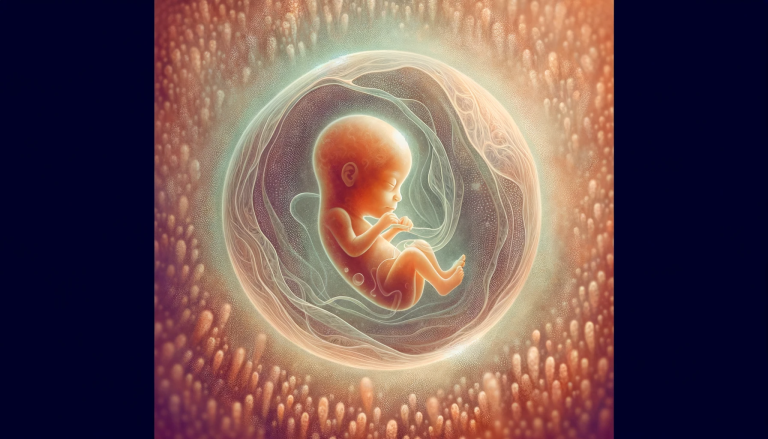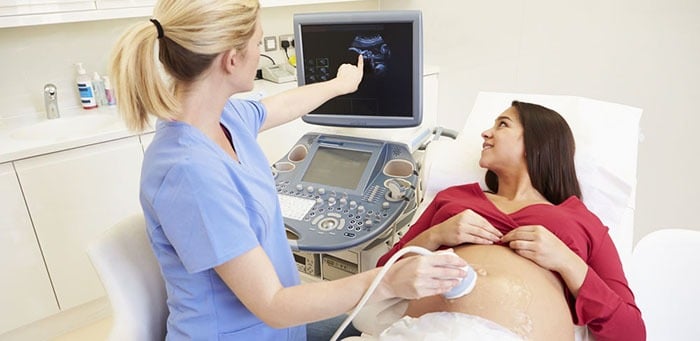Ultrasound is a critical tool for the diagnosis and management of suspected early pregnancy loss.
Early Pregnancy Loss
Early pregnancy loss is defined as a nonviable, intrauterine pregnancy with either an empty gestational sac or a gestational sac containing an embryo or fetus without fetal heart activity within the first 12 weeks and 6 days of gestation. Other terms used are miscarriage, foetal demise, spontaneous abortion.
Incidence of Miscarriage
It is the most common complication of early pregnancy, affecting about 30% of pregnancies following assisted reproduction. It also affects 10% of spontaneously conceived pregnancies although this number does not represent the real incidents as vaginal bleeding – a common sign of early pregnancy loss – can be confused with delayed menses and the loss remains unrecognized.
Why Do Miscarriages Happen?
In more than 50% of all cases of early pregnancy loss, the most common cause is fetal chromosomal abnormalities with aneuploidy being the most frequent abnormality.
The most common risk factors identified among women who have experienced early pregnancy loss are advanced maternal age and a prior early pregnancy loss. The frequency of clinically recognized early pregnancy loss for women aged 20–30 years is 9–17%, and this rate increases sharply from 20% at age 35 years to 40% at age 40 years and 80% at age 45 years.
Other factors that could contribute to a miscarriage include:
- abnormal maternal hormone levels, such as thyroid hormone,
- Diabetes
- Exposure to radiation or toxic agents
- Some infections such as toxoplasmosis and listeriosis
- Congenital uterine abnormalities – It is very common for couples planning or trying to conceive to have a private transvaginal scan to check for any congenital uterine abnormalities.
- Health issues caused by cervical incompetence
- Some medications, such as Accutane
Other risk factors include smoking, alcohol and illegal drug use.
Symptoms of Miscarriage
Symptoms of a miscarriage might include:
- Vaginal Bleeding
- Lower abdominal cramping and pain
- Discharge of fluid or tissue from the vagina
- Loss of pregnancy symptoms
The most common symptom of miscarriage is vaginal bleeding that can vary from light spotting or brownish discharge to heavy bleeding and bright-red blood or clots.
Light vaginal bleeding is however relatively common during the first trimester of a pregnancy and does not necessarily mean you’re having a miscarriage. If you are concerned an early baby scan should be able to confirm or alleviate your fears.
Diagnosis of miscarriage
The most common test in the diagnosis of miscarriage is an ultrasound scan such as an early scan to check the health of your baby and look for a heartbeat.
Other tests include blood tests to measure the Human chorionic gonadotropin (hCG) a hormone associated with pregnancy.
Sometimes a miscarriage cannot be confirmed immediately using ultrasound or blood testing. If this is the case, you may be advised to have the tests again in 1 or 2 weeks.
Diagnosing Miscarriage With Ultrasound
The most accurate form of diagnosing miscarriage with ultrasound is during a transvaginal scan where a small probe is inserted into the vagina.
You may opt to have an external or abdominal scan through your abdomen. Transabdominal visualisation of the foetus, however, especially in the early weeks of gestation might be suboptimal. Both types of pregnancy scan are safe for the baby, and they do not increase your risk of miscarriage.
The ultrasound test can also confirm whether there are any retained products of conception (RPOC) – pregnancy tissue left in your womb (an incomplete or delayed miscarriage) or if all the pregnancy tissue has been passed out of your womb (a complete miscarriage).
What If Your Ultrasound Is Uncertain?
There will be many times when the ultrasound cannot conclusively say if you are too early in the pregnancy or you having a missed miscarriage.
Using ultrasound scans for the diagnosis of viable intrauterine pregnancy
Misdiagnosis of a miscarriage is a possibility and to avoid false positives in our private baby scan clinic in London we follow the same national guidelines the NHS follows.
These guidelines are as follows:
Inform women that the diagnosis of miscarriage using 1 ultrasound scan cannot be guaranteed to be 100% accurate and there is a small chance that the diagnosis may be incorrect, particularly at very early gestational ages.
When performing an early ultrasound scan to determine the viability of an intrauterine pregnancy, first look to identify a fetal heartbeat. If there is no visible heartbeat but there is a visible fetal pole, measure the crown-rump length. Only measure the mean gestational sac diameter if the fetal pole is not visible.
If the crown-rump length is less than 7.0 mm with a transvaginal ultrasound scan and there is no visible heartbeat, perform a second scan a minimum of 7 days after the first before making a diagnosis. Further scans may be needed before a diagnosis can be made.
If the crown-rump length is 7.0 mm or more with a transvaginal ultrasound scan and there is no visible heartbeat:
seek a second opinion on the viability of the pregnancy and/or perform a second scan a minimum of 7 days after the first before making a diagnosis.
If there is no visible heartbeat when the crown-rump length is measured using a transabdominal ultrasound scan:
record the size of the crown–rump length and perform a second scan a minimum of 14 days after the first before making a diagnosis.
If the mean gestational sac diameter is less than 25.0 mm with a transvaginal ultrasound scan and there is no visible fetal pole, perform a second scan a minimum of 7 days after the first before making a diagnosis.
Further scans may be needed before a diagnosis can be made.
If the mean gestational sac diameter is 25.0 mm or more using a transvaginal ultrasound scan and there is no visible fetal pole:
seek a second opinion on the viability of the pregnancy and/or perform a second scan a minimum of 7 days after the first before making a diagnosis.
If there is no visible fetal pole and the mean gestational sac diameter is measured using a transabdominal ultrasound scan:
record the size of the mean gestational sac diameter and perform a second scan a minimum of 14 days after the first before making a diagnosis.
Do not use gestational age from the last menstrual period alone to determine whether a fetal heartbeat should be visible.
Inform women that the date of their last menstrual period may not give an accurate representation of gestational age because of variability in the menstrual cycle.
Inform women what to expect while waiting for a repeat scan and that waiting for a repeat scan has no detrimental effects on the outcome of the pregnancy.
When diagnosing complete miscarriage on an ultrasound scan, in the absence of a previous scan confirming an intrauterine pregnancy, always be aware of the possibility of a pregnancy of unknown location. Advise these women to return for follow-up (for example, hCG levels, ultrasound scans) until a definitive diagnosis is obtained. (Source: nice.org.uk)
Management of Miscarriage
If you have been diagnosed with a miscarriage o your early pregnancy scan you might have several choices of management:
If you have no signs of infection, you might choose to let the miscarriage progress naturally. Usually, this happens within a couple of weeks of determining that the embryo has died. Unfortunately, it might take up to three or four weeks. This can be an emotionally difficult time. If expulsion doesn’t happen on its own, medical or surgical treatment will be needed.
If, after a diagnosis of certain pregnancy loss, you’d prefer to speed the process, medication can cause your body to expel the pregnancy tissue and placenta. The medication can be taken by mouth or by insertion in the vagina. Your health care provider might recommend inserting the medication vaginally to increase its effectiveness and minimize side effects such as nausea and diarrhoea. For about 70 to 90 per cent of women, this treatment works within 24 hours.
Another option is a minor surgical procedure called suction dilation and curettage ( D&C ). During this procedure, your health care provider dilates your cervix and removes tissue from the inside of your uterus. Complications are rare, but they might include damage to the connective tissue of your cervix or the uterine wall. Surgical treatment is needed if you have a miscarriage accompanied by heavy bleeding or signs of an infection.
Ultrasound after natural miscarriage
Before attempting to fall pregnant again, women sometimes book a private ultrasound scan such as a private pelvic scan to make sure that there is no retained products of conception and no uterine abnormalities.
Helpliness
The Lullaby Trust – lullabytrust.org.uk
Sands (Stillbirth and neonatal death charity) – sands.org.uk
The Miscarriage Association – miscarriageassociation.org.uk
Petals (Pregnancy Expectations Trauma and Loss Society) – petalscharity.org
You can find more information about help available in coping with pregnancy loss in our Baby Loss Helplines page.
References:
Ultrasound diagnosis of miscarriage: new guidelines to prevent harm – Assoc Prof George Condous doi: 10.1002/j.2205-0140.2011.tb00127.x
Ectopic pregnancy and miscarriage – NICE
Miscarriages – kidshealth.org
Miscarriages – Mayo Clinic
Missed Miscarriage – Radiopaedia
What happens next if I have miscarried? – Tommy’s
Ultrasound is a Critical Tool of Managing Miscarriage – Diagnostic Imaging
Diagnosis Miscarriage – NHS.uk
Ultrasound Scans – Miscarriage Association
Miscarriage – Harvard Medical School
Medically Reviewed by Tareq Ismail Pg(Dip), BSc (Hons)
About the Author: Yianni Kiromitis PgC (Medical Ultrasound), BSc(Hon)
I have 15+ years in ultrasound scanning and more than 20 years experience in Diagnostic Imaging. I have worked for multiple NHS hospitals as well as in the private sector.











